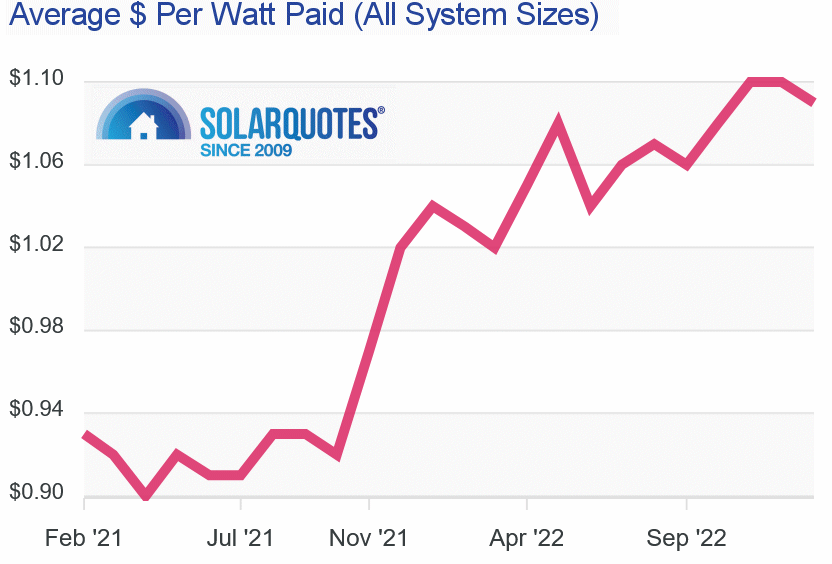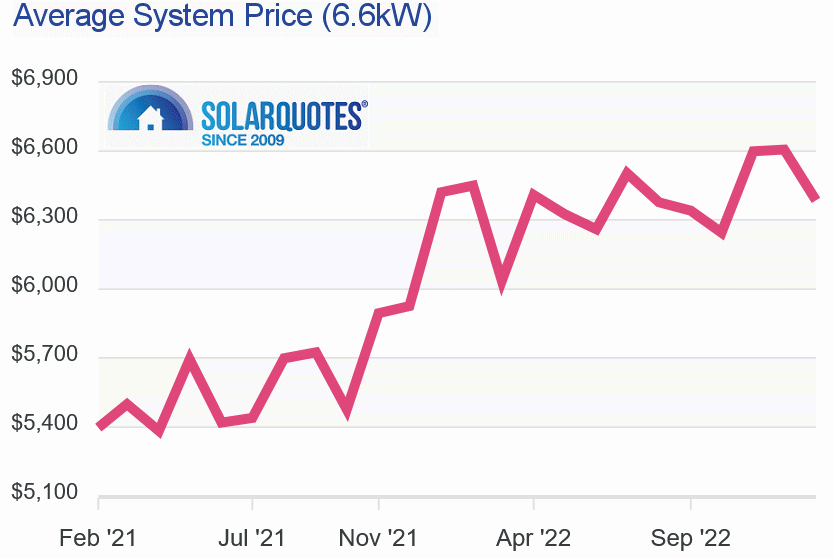Pricing for fully installed home solar power systems remained above the $1 per watt mark on average in January 2023 in each Australian state.
While cost-per-watt installed after all rebates and subsidies remained elevated, Victoria saw a significant drop compared to December 2022 – from $1.07 to $1.02. The state shares the distinction of the cheapest solar in Australia for the month with Western Australia. Across the border in South Australia, solar prices increased from $1.04 to $1.09.
Here’s how the states and the ACT are stacking up for January so far.
| State | Cost per watt (January 2022) |
Cost per watt (December 2022) |
Cost per watt (January 2023) |
| QLD | $1.03 | $1.06 | $1.06 |
| NSW | $1.09 | $1.19 | $1.19 |
| ACT | $1.33 | $1.39 | $1.43 |
| VIC | $1.08 | $1.07 | $1.02 |
| TAS | $NA | $1.20 | $NA |
| SA | $0.95 | $1.04 | $1.09 |
| WA | $0.92 | $1.00 | $1.02 |
| NT | NA | NA | NA |
| AU | $1.04 | $1.10 | $1.09 |
The table above is based on pricing information included in 232 solar installer reviews submitted to SolarQuotes as at February 23 covering contracts signed in January this year. The number of reviews where costs for systems purchased in January were included are a little light-on so far compared to other months. As new reviews come in, the figures above will likely change.
Cost Per Watt – National Historical Averages
The graph below indicates cost-per-watt pricing across all system sizes nationally since February 2021. Back then, Australians were paying around 93c a watt on average compared to $1.09 in January 2023. It’s quite a jump, but something else that has jumped significantly in recent times are electricity prices; so uptake of home solar power systems remains pretty healthy.
6.6kW And 10kW System Prices – January 2023
Average pricing for fully installed 6.6kW solar reduced from around $6,600 in December to $6,385 in January at this point. Again, the figures are likely to change as more reviews come in.
Indications are 10kW solar power systems crept up in price – from $11,540 in December 2022 to $11,659 in January 2023.
To keep track of pricing movements as new information comes in, use the SolarQuotes Australian Solar Price Index. Note that the system costs are based on a broad range of quality and installation scenarios. To see general pricing ranges currently for good quality systems, see our solar panel costs page.
Power Prices Making Panels Particularly Attractive
Many Australians have faced increased electricity charges over the last 6 months or so, and they aren’t over yet.
To help beat ballooning electricity bills, comparing electricity plans is a wise step. So too is going solar. While systems may be pricier than they were a couple of years ago, they still offer fantastic value for money assuming you have a suitable rooftop – and even more so under current conditions. But, if you’re going get panels it’s important do it right to maximise your returns.
To get an idea of how much you could be saving by installing solar panels – and estimated payback times in your circumstances – try the SolarQuotes solar (and battery) calculator.




 RSS - Posts
RSS - Posts



Completely unrelated question but some bright spark (pun semi-intended) might have an answer.
Is there any legislation or service guarantees regarding the provision of power?
It’s week 8 of 2023 and we’re up to about half a dozen powercuts!!! They’re only short true, but it’s enough to mess up the inverter, the computer, the clocks etc. I wouldn’t expect such poor service in the bush – assuming a power connection, I definitely don’t expect it with town power.
Aside from going fully off-grid i.e. adding batteries and a fossil fuel generator, are there any other options???
I checked my supplier earlier and there’s no listing of a power outage, but I can only check via phone or internet when the power is running, which means the outage is over, and when it’s over there’s no more outage to report, assuming it was ever listed in the first place.
Any suggestions?
The good news is if you have too many blackouts – or for too long – you can receive compensation. Here is some Queensland Energex information:
https://www.energex.com.au/about-us/our-commitment/to-our-customers/guaranteed-service-levels
And here’s South Australia info:
https://www.sapowernetworks.com.au/your-power/quality-reliability/guaranteed-service-level-payment/
What is the difference in KW sizes of your solar systems, what do the sizes mean? I have a 6.5 Kw system with 22 panels.
Hi Ross,
As Michael states in the article, this information is based on data from 232 reviews left by users of our site. When they leave a review, they tell us the size in kWs, ranging from small systems of 3 kW up to 10s of kWs. 6.6 kW is the most common system size installed today.
Does that answer your question?
6.5Kw = 6,500w
For 22 panels they are each producing 6,500/22 = 295 watts per panel.
My panels are rated at 375w and I have 26 panels.
So my system is 375×26 = 9,750w (aka 9.75Kw)